Mapping Diversity: Developing a European Classification of ... - U-Map
Mapping Diversity: Developing a European Classification of ... - U-Map
Mapping Diversity: Developing a European Classification of ... - U-Map
Create successful ePaper yourself
Turn your PDF publications into a flip-book with our unique Google optimized e-Paper software.
• the classifi cation should allow fl exibility in the sense that institutions can ‘move’ between<br />
12<br />
categories and that dimensions, criteria and categories can be adapted;<br />
• the classifi cation should be parsimonious regarding extra data-gathering needs;<br />
• the classifi cation should be related to the <strong>European</strong> policy on quality assurance, in particular<br />
the <strong>European</strong> Quality Assurance Register in Higher Education (EQAR).<br />
Based on these principles a draft-classifi cation was developed that consists <strong>of</strong> 14 dimensions and<br />
a set <strong>of</strong> indicators per dimension. The dimensions and indicators were selected in an interactive<br />
process with the stakeholders and experts and were developed to cover the crucial characteristics<br />
<strong>of</strong> higher education institutions in Europe and to allow relevant differentiation between these<br />
institutions.<br />
Regarding the relationship between the <strong>European</strong> classifi cation and quality assurance, the following<br />
suggestions were made:<br />
• the classifi cation should not be seen as an instrument for ranking higher education institutions.<br />
The multi-dimensional and non-hierarchical characteristics <strong>of</strong> the classifi cation imply that a<br />
number <strong>of</strong> different comparisons and categorizations <strong>of</strong> higher education institutions can be<br />
made, that cannot lead to one ‘league table’. However, the classifi cation instrument cannot<br />
prevent users from ranking institutions per dimension. Such rankings may be assumed to be<br />
more useful and fair than aggregated rankings;<br />
• the classifi cation is not an instrument for institutional quality measurement. It does not generate<br />
quality judgments about higher education institutions, nor about their educational and research<br />
programmes. It describes the ‘pr<strong>of</strong>i les’ <strong>of</strong> these institutions on the basis <strong>of</strong> ‘objective’, empirical<br />
and reliable data. These descriptions can <strong>of</strong> course be used in quality measurement and<br />
assurance processes, but in order to be able to do so criteria for the judgment <strong>of</strong> quality have<br />
to be added to the descriptions;<br />
• in order to create a clear relationship with the <strong>European</strong> Register <strong>of</strong> Quality Assurance Agencies<br />
(EQAR), only those higher education institutions whose programmes are successfully reviewed<br />
by a registered quality assurance or accreditation agency should be included in the classifi cation.<br />
In this way only reputable higher education providers will be included.<br />
Table 1 <strong>of</strong>fers an overview <strong>of</strong> the draft and classifi cation. As was indicated earlier this classifi cation<br />
consists <strong>of</strong> 14 dimensions and a set <strong>of</strong> indicators per dimension. The indicators make it possible to<br />
differentiate between institutions and to construct different categories per dimension. In the draftclassifi<br />
cation these categories were only provisionally developed.<br />
MAPPING DIVERSITY

















